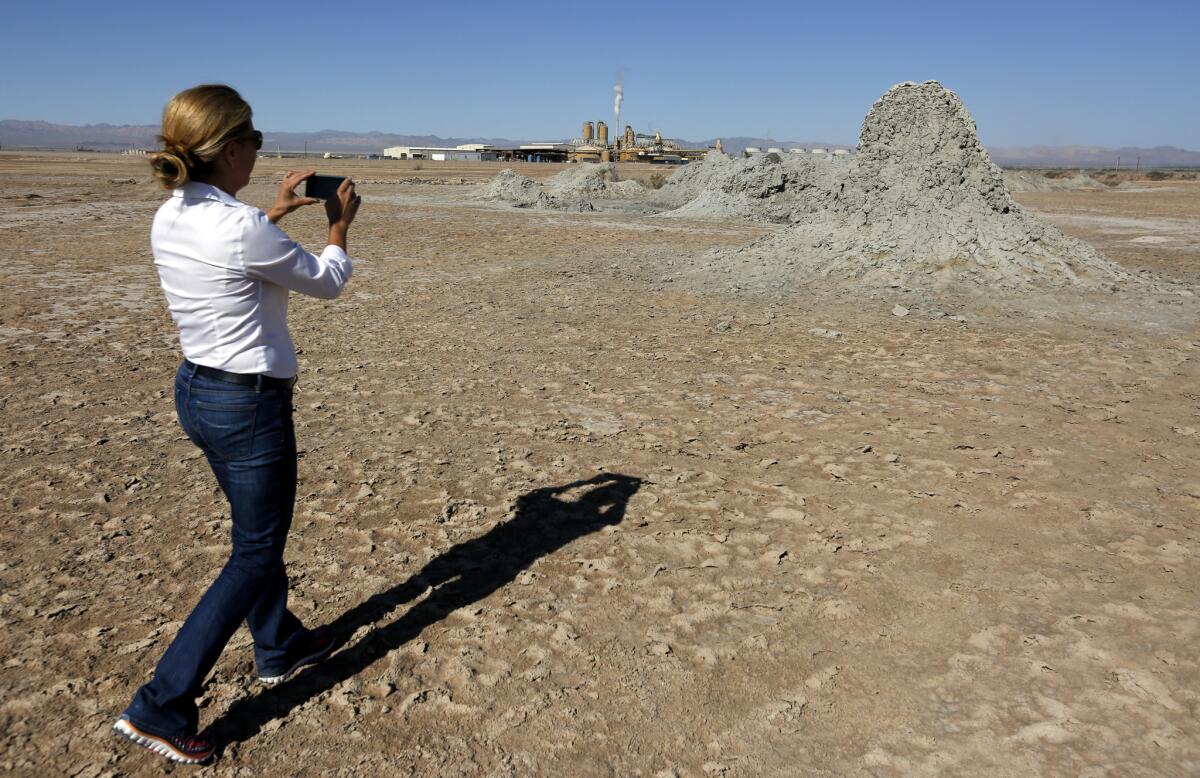Australian firm plans nation’s largest geothermal plant in Imperial Valley

- Share via
In California’s southeastern desert, where an abundance of clean energy boils just beneath the surface, two start-up firms aim to build the nation’s largest geothermal power plant and mining operation.
Controlled Thermal Resources and Alger Alternative Energy plan to tap the Imperial Valley’s geothermal resources to bring a power plant online as early as 2020 that would be able to generate nearly six times the electricity as similar facilities in the area. In addition, the mining operation would begin extracting lithium carbonate — used for battery production — as well as manganese, zinc and other minerals in 2019.
The Salton Sea area is one of the world’s largest sources of geothermal energy — where the earth’s heat and pressure create hot water and steam to turn electricity generating turbines 24 hours a day.
California is no stranger to geothermal power.
The state first began using the resource to generate electricity in 1960 at the Geysers, north of San Francisco. Federal energy legislation in 1978 further spurred geothermal development, but it was deemed too expensive a renewable energy and fell out of favor as solar- and wind-energy projects became more affordable.
Although power plant developers have built several small geothermal units around the Salton Sea, none has attempted the kind of operation now proposed. That’s because the typically high cost of drilling wells and building power plants is further complicated there by the high salt content of the shrinking sea.
The two companies say they have resolved the economic challenges by planning bigger operations and designing processes to minimize the adverse effect of the salt.
“We’re taking advantages of economies of scale” to produce power cheaply enough to lure utilities and other buyers, said James Turner, business development manager for Controlled Thermal Resources, which is building the power plant. “We’ve chosen to base our financial modeling with no government subsidies at all.”
In addition, CTR will receive royalties from Alger Alternative Energy’s sale of the minerals it extracts from the operation, which will bolster the power plant operation’s bottom line. One of the primary minerals is the resource used in making lithium-ion batteries, which are becoming increasingly popular in energy storage for cars, homes and utility power plants.
Alger Alternative estimates there are 100 million metric tons of recoverable lithium around the Salton Sea. Experts estimate that lithium-ion battery demand could reach 300,000 metric tons a year by 2020, so the company sees a growing market for the product.
“This is a substantial reservoir,” said Tracy Sizemore, chief executive of Alger Alternative. “People have looked at mineral production there for a long time.”
A previous attempt to harvest the minerals resulted in a notable failure.
Symbol Inc. attempted a mining operation that drew attention from billionaire Elon Musk, chief executive of Tesla Motors. Tesla offered to buy Symbol for a reported $325 million, but Sizemore said the company refused the offer in hopes of a better deal.
Before that could happen, Symbol ran out of money and the mining operation faltered. Alger Alternative formed to buy it out of receivership.
Sizemore, who worked at one time for Symbol, said the company was hurt by financial management problems but Symbol’s mining technology “is solid.”
“The technology has been validated,” Sizemore said. “There was no technology risk.”
The Imperial Irrigation District awarded CTR an agreement for up to 50 years to lease 1,880 acres for the power plant and mining operations, if milestones are reached.
Marion Champion, a spokeswoman for the irrigation district, said a 2003 study estimated that mining royalties at the Salton Sea could reach $1.5 billion — $51 million annually to mineral rights owners like the Imperial Irrigation District — between 2016 and 2045.
“Of course those are just estimates,” Champion said. “However, IID believes that geothermal development and additional research into mineral extracting are key components of a well-balanced solution for the Salton Sea.”
Royalties from mineral extraction and revenue to the irrigation district from the power plant operations are seen by environmentalists as a potential help for restoration of the Salton Sea, which has been shrinking in the years-long state drought.
The exposure of more of the Salton Sea shoreline has revealed geothermal’s further potential.
Champion noted that experts have estimated there is between 1,600 and 2,000 megawatts of untapped geothermal potential at the sea. The irrigation district and Imperial County have been working to develop the resource.
CTR initially proposes to tap the geothermal for a 280-megawatt plant with an eye toward developing 750 megawatts of the resource. Coupled with the existing 450 megawatts of geothermal power, the Imperial Valley would be a leader in use of the energy source for electricity as well as tapping the available minerals.
With the current roughly 450 megawatts of geothermal power plant development, the additional 750 megawatts would make the Imperial Valley a leader in use of the energy source for electricity.
Geothermal plants have virtual no emissions and the mining operation will register as negative emitter of carbon.
What is unclear is whether Controlled Thermal Resources, which was formed in 2013 by Australian investors, will deliver the large scale power plant it proposes along with Alger Alternatives’ mineral operation.
CTR declined to discuss specifics but did say that its power plant would be cost-competitive with coal-fired plants, although natural gas, wind and solar probably still would be cheaper.
“As a new player, Controlled Thermal Resources is an unknown,” said Micah Mitrosky, environmental organizer for the International Brotherhood of Electrical Workers Local 569 union. “If they are done right, geothermal projects at the Salton Sea can create middle-class construction careers for local residents, provide clean reliable energy to address our climate crisis and complement conservation efforts to help protect public health and prevent a crisis at the Salton Sea.”
CTR’s power plant design mirrors a facility built in New Zealand. The company plans to apply for permits to drill exploratory wells in February and to submit an application for the plant to the California Energy Commission toward the end of 2017.
The company has not secured agreements with utilities to buy the power but is negotiating with public and investor-owned power companies.
“The risk is all on us because we’re a private company,” said Turner, CTR’s chief executive. “We’ll be able to offer a competitive geothermal price. We’re competitive with this.”
For more energy news, follow Ivan Penn on Twitter: @ivanlpenn
ALSO
Nearly 200 earthquakes hit Salton Sea amid quake swarm
Risk of big earthquake on San Andreas fault rises after quake swarm at Salton Sea
Trump brings Koch network’s green-energy foes from the fringe to the center of power
Op-Ed: Where’s the money and the plan that will save the Salton Sea?
More to Read
Inside the business of entertainment
The Wide Shot brings you news, analysis and insights on everything from streaming wars to production — and what it all means for the future.
You may occasionally receive promotional content from the Los Angeles Times.











